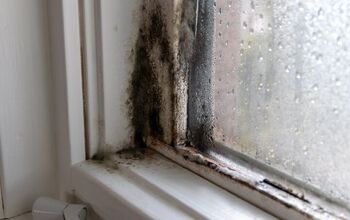At What Temperature Does Mold Die? (Find Out How To Kill Mold!)

It is a matter of health and safety when you discover mold in your home. Luckily, homeowners have performed DIY mold remediation for long enough that we know mold is sensitive to extreme temperatures. So, what temperature does mold die?
Mold dies at higher temperatures of 140-160 degrees Fahrenheit. The temperature must stay over 140 degrees for up to 25 minutes to kill mold spores during heat treatment. Extreme cold temperatures below 32 degrees Fahrenheit or 0 degrees Celsius can kill mold spores or make them inactive.
Heat treatments are among the most effective types of mold remediation, as long as you do it correctly. It is difficult to rely on extreme cold weather to kill mold spores, but it is possible if you live in the proper climate. Follow along as we explore the important question; at what temperature does mold die?
Do You Need Mold Removal Services?
Get free, zero-commitment quotes from pro contractors near you.

What Temperature Does Mold Die?
Mold can die if the temperature is between 140 and 160 degrees Fahrenheit. The extreme heat can kill many living pests or living organisms, and that includes mold. Heat treatment is one of the most common and effective ways to eradicate mold and yeast.
You can even kill mold that your food contains with heat, but that doesn’t necessarily mean you should eat it. Some mold spores can resist heat, and you may need to reach a temperature closer to 200 degrees Fahrenheit to kill them. Maintain a consistent temperature above 140 degrees Fahrenheit for 20-25 minutes to eradicate the mold.
Consistency is just as important as temperature, no matter how much mold you have. The spores should all die in 25 minutes or less if the temperature never drops below 140-160 degrees. You can repeat mold heat treatments multiple times if you need to, but it shouldn’t be necessary if you blast the problematic area.
What Temp Does Mold Die Cold?
Mold can die if the temperature drops below 32 degrees Fahrenheit or 0 degrees Celsius. However, mold spores can sometimes live in sub-freezing levels. The mold isn’t active at freezing temperatures even if it doesn’t die, but it can still live in some cases even when inactive.
Common mold prefers temperatures between 65 and 70 degrees Fahrenheit. It is uncommon for mold to survive cold temperatures, but it can happen in some cases especially if there is moisture. You cannot perform mold remediation with cold temperature treatment, but it can occur naturally if the air stays below freezing around the spores.
How Effective Is Killing Mold With Heat?
Truthfully, it’s not exactly the most reliable method since there are some strains that can resist surprisingly high temperatures. If you want to make sure that you can kill mold with heat, check to see if it’s a heat resistant strain. If it’s not, you should be good to go.
Heat is not the most effective method, but it still works fairly well. To keep things on the safe side, it’s best to treat mold with a fungicide like white vinegar or bleach, alongside a heat treatment. This is especially true if you identified black mold in your home.
How Do You Kill Mold With Heat?
There are several ways to kill mold spores using heat, each of which has its own uses. To make things easier, we’re going to offer up a how-to on each of the most common ways people get rid of mold with heat.
Laundry
Moldy laundry? Mildewy stuffed bear? Yikes, but it happens. If you have this occur, pop your items into the dryer on the highest possible heat setting. From there, set the timer to 20 to 25 minutes at a bare minimum. Once you’ve done that, the mold should be dead and you can launder your materials as you normally would.
Baking It
Once in a while, you might end up forgetting some dirty dishes in the sink…to the point of it growing mold. (Okay, maybe not, but bear with me here.) If you find that you have mold growing on ceramics, metals, or similar materials, you can bake it. To do this, you just have to pop the affected items in the oven at 300 for 20 minutes.
Don’t feel like baking it? You might be able to get rid of mold by leaving it in a hot car on a 90-degree summer day for around six hours. However, this is more of a backup method than anything else.
Heating Units
For the most part, you will only see people use heat to kill mold on smaller items like stuffed animals and glassware. However, there are moments where heating units and hair dryers can be used to kill mold on walls. In order for this to work, you may need to get specialty space heaters capable of reaching temperatures that high.
Sometimes, space heaters alone can do this, if it’s a small area. However, you probably will need to get a heat treatment for bed bugs in order to get rid of the mold through this method. To finish up, we suggest doing a quick wipe with a diluted bleach or white vinegar solution to ensure that your mold is dead.
Will Heat Alone Kill Mold?
In many cases, yes. Just heating the area alone will be enough to get rid of mold. However, you also should strongly consider doing some prevention and cleanup in order to avoid unsightly messes or regrowth. These tips below can help you get rid of mold for good:
- To clean up and kill any additional mold, make sure that you wipe down the area with a mold-killing solution. We suggest a diluted bleach solution, hydrogen peroxide, or a diluted white vinegar solution.
- Make sure that the area has been completely heated if you are going to use heat alone. This may seem pretty obvious, but it’s not. If you are dealing with mold that has sunk through several layers of fabric, you will need to keep your fabric at a higher heat and ensure that the core area has reached at least 140 degrees.
- Keep areas affected by mold away from moisture and darkened areas. This should be obvious, but it’s worth noting once again. Moisture is one of the leading predictors of mold. Heat alone is not enough to kill mold if it’s all wet.
- If the mold is exceptionally pervasive, you will need to use multiple treatments. It’s important to realize that a chemical-free treatment isn’t always doable.
- Using mold-proofing paint and finishes can help prevent mold regrowth. Of course, these should be applied to areas that have been cleaned and appropriately prepped for paint.
Should You Use Heat to Kill Mold?
Heat is one of the most effective ways to kill living organisms in your house such as mold and bed bugs. Mold is a living nuisance in your house that can cause respiratory problems and severe illness. Extreme temperatures kill bacteria and mold easily, but the treatment is relegated to a specific area.
Professional heat treatment costs an average of $3,225, but it can cost as little as $400. The cost varies based on how many square feet you need to cover and how long it takes. It is important to inspect for mold throughout the house before you perform a heat treatment.
Mold spores can travel within the air throughout your house, and it’s ideal to treat each cluster at once. Professionals typically use an air scrubber in conjunction with heat to clean the air and kill mold simultaneously.
Do You Need Mold Removal Services?
Get free, zero-commitment quotes from pro contractors near you.

Related Questions
How do you prevent mold from growing?
Mold can be prevented by fostering an environment that doesn’t bode well for its growth. To do this, make sure your area is well-lit, ventilated, and does not carry high levels of moisture. Keeping the area clean can also help prevent mold spores from finding their way in.If you recently had a major flood that exposed your home to mold and mildew, you need to clean it up and dry the area as soon as possible. Otherwise, mold will be a surefire product of the flood.
How hot does it have to be to kill bed bugs?
Bed bugs cannot survive above 120 degrees Fahrenheit, but it can take up to half an hour or more to kill them at that temperature. In order for bed bugs to be instantly killed, you have to turn the heat up to 140 degrees Fahrenheit. Like with other heat treatments, you need to make sure the entire affected area is heated thoroughly to ensure that it works.
Can you paint over mold to kill it?
Contrary to popular belief, painting over mold does not actually kill the mold. It doesn’t even kill the source of the mold. Prior to painting any sort of mold, you need to eradicate it and ensure that the source has been removed. Otherwise, mold will grow through the paint and potentially ruin the wood underneath.
Related Guides

Ossiana Tepfenhart is an expert writer, focusing on interior design and general home tips. Writing is her life, and it's what she does best. Her interests include art and real estate investments.
More by Ossiana Tepfenhart














![10 Best Electric Lawn Mowers - [2022 Reviews & Top Rated Models]](https://cdn-fastly.upgradedhome.com/media/2023/07/31/9070486/10-best-electric-lawn-mowers-2022-reviews-top-rated-models.jpg?size=350x220)












